What Is RG316 Cable? Specs, Loss, Power Rating & Comparisons
Aug 30,2025
Introduction
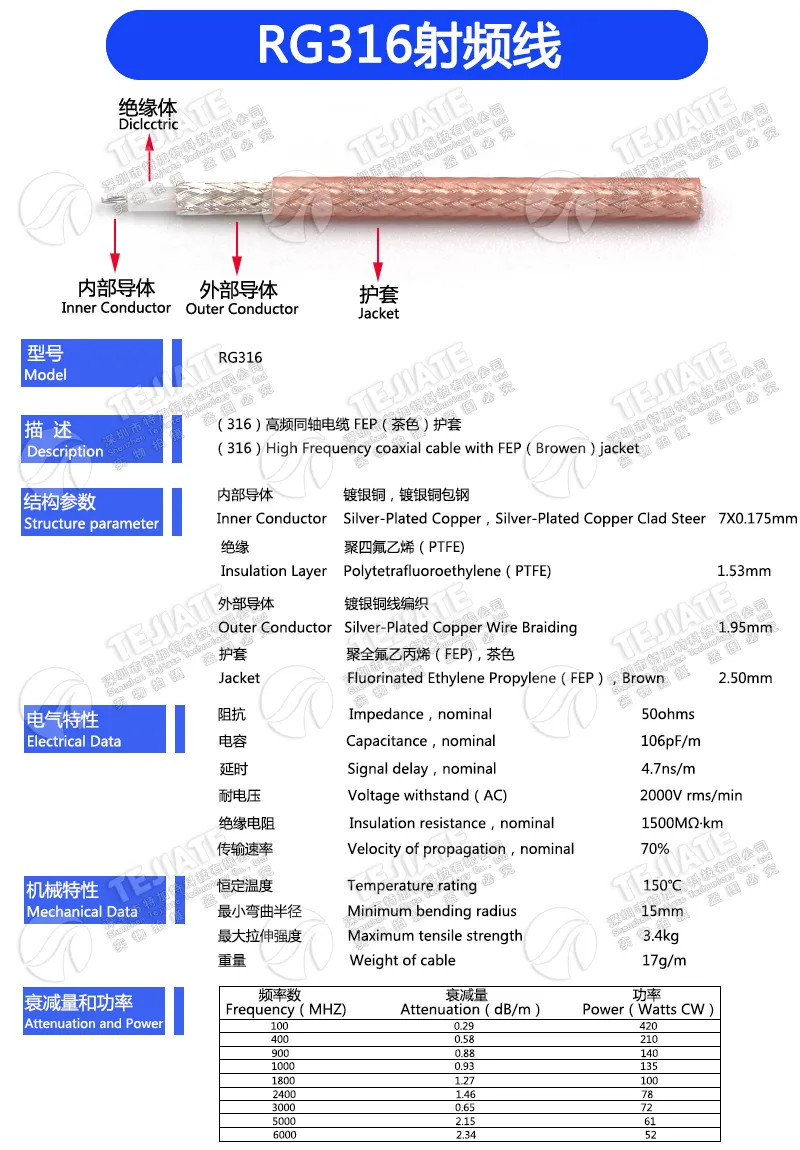
This technical diagram provides a detailed breakdown of the RG316 coaxial cable's construction. It clearly labels the four key layers: the inner conductor (often 7x0.175mm silver-plated copper), the PTFE (Teflon) dielectric insulation (~1.53mm), the braided silver-plated copper outer conductor/shield (~1.95mm), and the durable brown FEP outer jacket (~2.5mm OD). This visual explains the material choices that give RG316 its flexibility, high-temperature resistance, and stable RF performance.
If you work around RF systems, test equipment, or wireless modules, chances are you’ve run into a thin brown coaxial line labeled RG316 cable. At first glance, it doesn’t look like much—just another small, flexible wire. Yet this modest cable plays a vital role in short-range RF connections, especially in demanding environments where flexibility, heat resistance, and stable performance matter.
Unlike larger coaxial standards such as RG58 or LMR400, RG316 is not designed to carry signals across long outdoor runs. Instead, it shines in applications like test jumpers, antenna pigtails, or compact device assemblies where space is limited. Engineers often favor it in labs and aerospace settings because it bends easily without breaking and withstands high temperatures.
In this guide, we’ll break down what makes RG316 unique, from its structure and electrical specifications to its loss performance and power rating. We’ll also compare it directly with similar cables such as RG174 and RG58, so you’ll know when RG316 is the right choice—and when it’s better to pick something else.
What Is RG316 Cable?
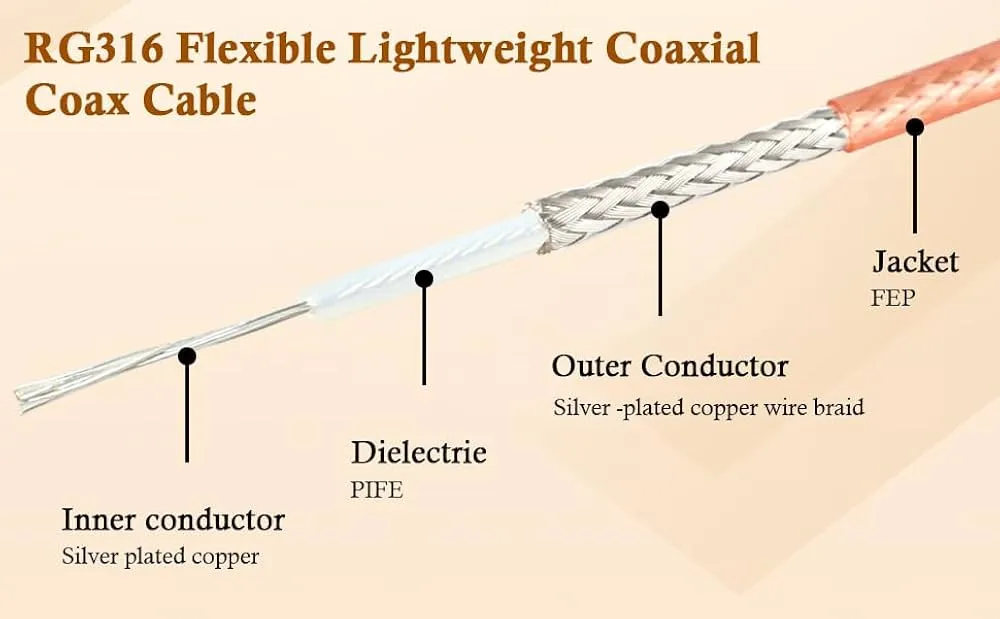
This image provides a clear, visual summary of the materials that constitute an RG316 cable. It complements the textual description by illustrating the silver-plated inner conductor for good conductivity, the PTFE dielectric for low loss and high heat resistance, the braided outer conductor for shielding, and the robust brown FEP jacket that protects against physical and environmental damage, enabling its use in demanding applications.
At its core, RG316 coaxial cable is a 50-ohm flexible RF cable. It follows the same fundamental design as other coax types: an inner conductor, an insulating dielectric, a braided shield, and an outer jacket. What sets it apart is the material choice and build quality.
- The inner conductor is typically silver-plated copper or copper-clad steel.
- The dielectric insulation uses PTFE (Polytetrafluoroethylene), which provides stable electrical properties and excellent temperature tolerance.
- The braided outer conductor is silver-plated copper wire, delivering solid shielding performance.
- Finally, the outer jacket is made from FEP (Fluorinated Ethylene Propylene), recognizable by its brown color, and rated for use from -55°C up to +200°C.
Because of these materials, RG316 offers both mechanical durability and consistent RF performance rated to ~3 GHz; very short jumpers can be usable up to ~6 GHz depending on length and assembly quality. That makes it suitable for Wi-Fi, GPS, LTE, and even some 5G sub-6 GHz applications—though only at short distances due to its relatively high loss.
RG316 Cable Specifications
| Parameter | RG316 Value | Notes |
|---|---|---|
| Impedance | 50 Ω nominal | Standard for RF transmission |
| Outer Diameter | ~2.5 mm | Very thin, highly flexible |
| Inner Conductor | Silver-plated copper (SPC) or copper-clad steel (CCS), 7×0.175 mm | Approx. 25–26 AWG equivalent; good conductivity/flexibility |
| Dielectric | PTFE, ~1.53 mm | Low loss, stable with temperature |
| Shielding | Silver-plated copper braid, ~1.95 mm | Moderate shielding effectiveness |
| Jacket | FEP (brown), ~2.5 mm | Resistant to heat and chemicals |
| Capacitance | ~95–100 pF/m (typ. ~96.5 pF/m) | Influences velocity factor |
| Velocity of Propagation | ~70 % | Typical for PTFE dielectrics |
| Insulation Resistance | ≥1500 MΩ·km | High reliability |
| Max Working Voltage | ~1200 V rms | Suitable for lab and aerospace use |
| Dielectric Withstand Test | ~2000 V rms for 1 min | Factory test (not continuous rating) |
| Temperature Range | -55 °C to +200 °C | Much higher than PVC-jacket cables |
Why does this matter in practice? For starters, that tiny 2.5 mm outer diameter means you can route RG316 inside cramped devices or tight enclosures where bulkier cables simply won’t fit. The FEP jacket also makes it resistant to sunlight, dust, and even freezing conditions, which is why you’ll see it in aerospace harnesses and outdoor RF test setups.
Expert note: In the lab, RG316 jumpers are common because you can bend them around crowded benches without stressing connectors. Still, always remember that its small size comes at a cost—signal loss is significant at higher frequencies, so it’s best kept short.
RG316 Cable Loss & Power Handling
One of the first things engineers notice when working with RG316 coaxial cable is its relatively high attenuation. Simply put, the thinner the cable, the greater the loss per unit length—especially at microwave frequencies. RG316 is no exception. While its flexibility and heat resistance are excellent, you’ll pay the price in signal strength if you stretch it too far.
The table below shows typical attenuation values for RG316 over common frequency bands. The numbers are given per 100 feet, which is a standard way of rating coaxial cable performance.
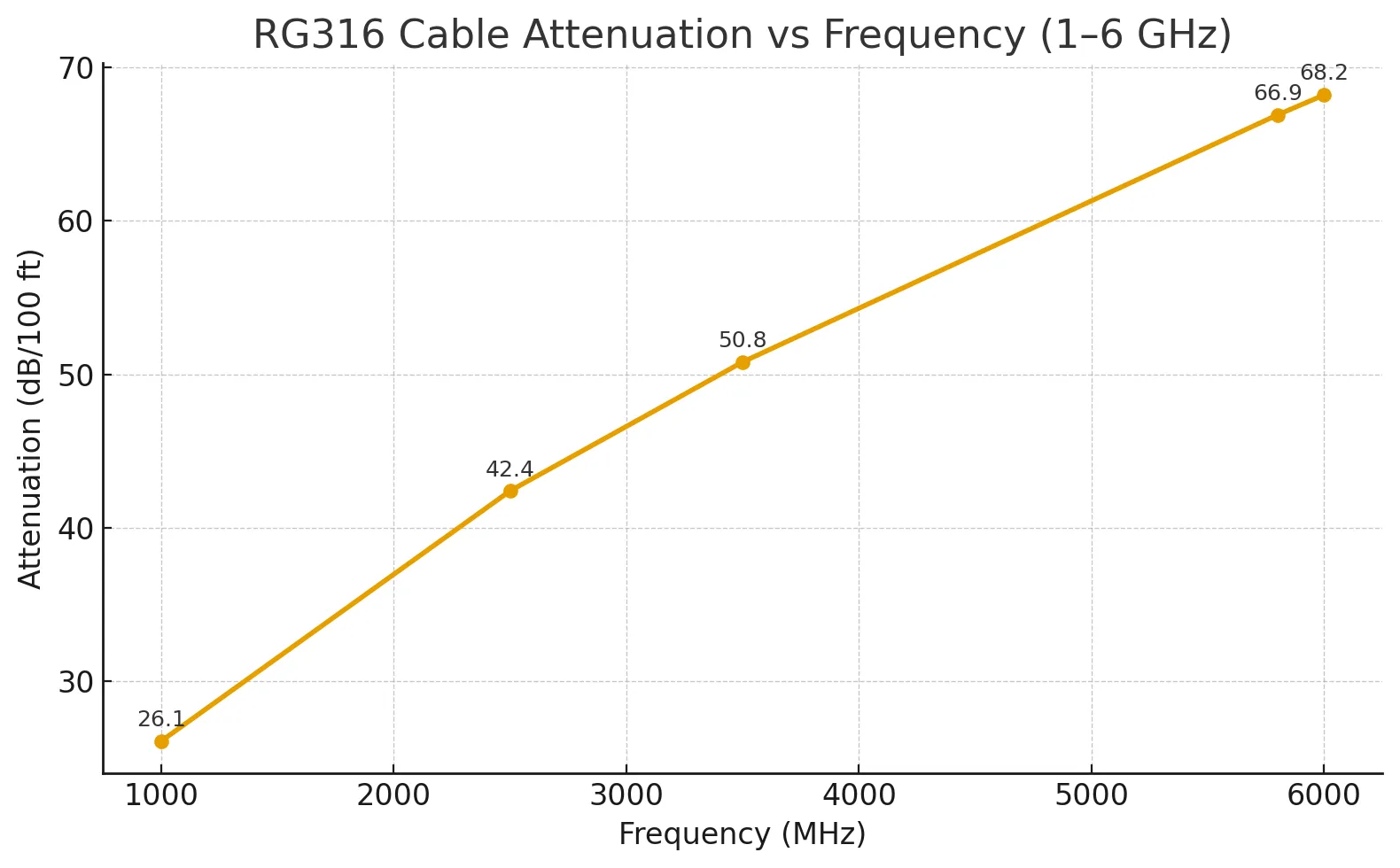
This line chart is a crucial visual for understanding the primary limitation of RG316 cable: its high attenuation at higher frequencies. The graph clearly shows a steeply rising curve, quantifying the signal loss in dB per 100 feet across common Wi-Fi, cellular, and 5G bands (e.g., ~26 dB/100ft @ 1GHz, rising to ~68 dB/100ft @ 6GHz). This emphasizes why RG316 is only suitable for very short cable runs in high-frequency applications.
| Frequency | Attenuation (dB/100 ft) | Attenuation (dB/100 m) | Common Applications |
|---|---|---|---|
| 1 GHz | ~26.1 dB | ~85.6 dB | GSM, LTE Low Band |
| 2.5 GHz | ~42.4 dB | ~138.9 dB | Wi-Fi 2.4 GHz, LTE Mid Band |
| 3.5 GHz | ~50.8 dB | ~166.5 dB | 5G NR n78, CBRS, Wi-Fi |
| 5.8 GHz | ~66.9 dB | ~219.5 dB | Wi-Fi 5 GHz, IoT links |
| 6 GHz | ~68.2 dB | ~223.6 dB | Wi-Fi 6E, 5G Sub-6 GHz |
Looking at the RG316 loss chart, the trend is obvious: as frequency increases, signal attenuation rises sharply. At 1 GHz, RG316 is around 26 dB/100 ft per 100 ft, which is manageable for short jumpers. But by 5.8 GHz, it rises to roughly 67 dB/100 ft, making even a half-meter run significant in sensitive RF setups.
That’s why RG316 is almost never used for long cable runs. Instead, it’s reserved for short jumpers, pigtails, and test leads where a few decibels of loss are manageable.
As for power handling, RG316 is modest. At around 1 GHz, it can manage roughly 35 watts, which is fine for lab work or small transmitters. Compare that with thicker cables like RG58, which can handle close to 180 watts under similar conditions. The difference comes from simple physics: a larger conductor and dielectric can dissipate more heat and spread current more effectively.
From a practical standpoint, you should think of RG316 as a “precision tool” rather than a heavy-duty workhorse. It’s perfect for connecting an RF module to a nearby antenna inside an enclosure, or linking a device to test equipment on the bench. But if you’re powering a long outdoor antenna line, look elsewhere.
RG316 Cable Comparisons
| Feature | RG316 | RG174 | RG58 | RG400 |
|---|---|---|---|---|
| Impedance | 50 Ω | 50 Ω | 50 Ω | 50 Ω |
| Outer Diameter | ~2.5 mm | ~2.8 mm | ~5.0 mm | ~5.0 mm |
| Frequency Range | DC–3 GHz (short jumpers usable to 6 GHz) | DC–3 GHz | DC–1 GHz (usable to ~2 GHz) | DC–6 GHz |
| Attenuation @1 GHz | ~26 dB/100 ft | ~29 dB/100 ft | ~21 dB/100 ft | ~14.7 dB/100 ft |
| Attenuation @2.4 GHz | ~43 dB/100 ft | ~49 dB/100 ft | ~32 dB/100 ft | ~25 dB/100 ft |
| Power Handling (@1 GHz) | ~85 W | ~17 W | ~44 W | ~500 W |
| Temperature Range | -55 °C to +200 °C | -40 °C to +80 °C | -20 °C to +85 °C | -55 °C to +200 °C |
| Flexibility | High | High | Moderate | Moderate |
| Typical Use | Test jumpers, RF modules, aerospace | GPS pigtails, budget RF | WLAN, CB radio, base feeders | High-performance RF, military use |
RG316 vs RG174: Both are small, flexible cables. RG316 has better temperature resistance thanks to its FEP jacket, making it suitable for aerospace or outdoor use. RG174 is cheaper but degrades quickly in heat.
RG316 vs RG58: RG58 is thicker and much better at carrying power with lower loss. But it’s stiffer, making it less practical inside compact devices.
RG316 vs RG400: RG400 combines flexibility with much lower attenuation, but it’s significantly bulkier and heavier. You’ll find it in military and aerospace, where performance outweighs size.
In short: RG316 is the go-to when you need small, flexible, high-temp coax—just don’t expect miracles in power or loss.
Common Applications of RG316 Cable
Despite its higher loss, RG316 coaxial cable has carved out a niche where other cables struggle. Engineers and integrators rely on it for:
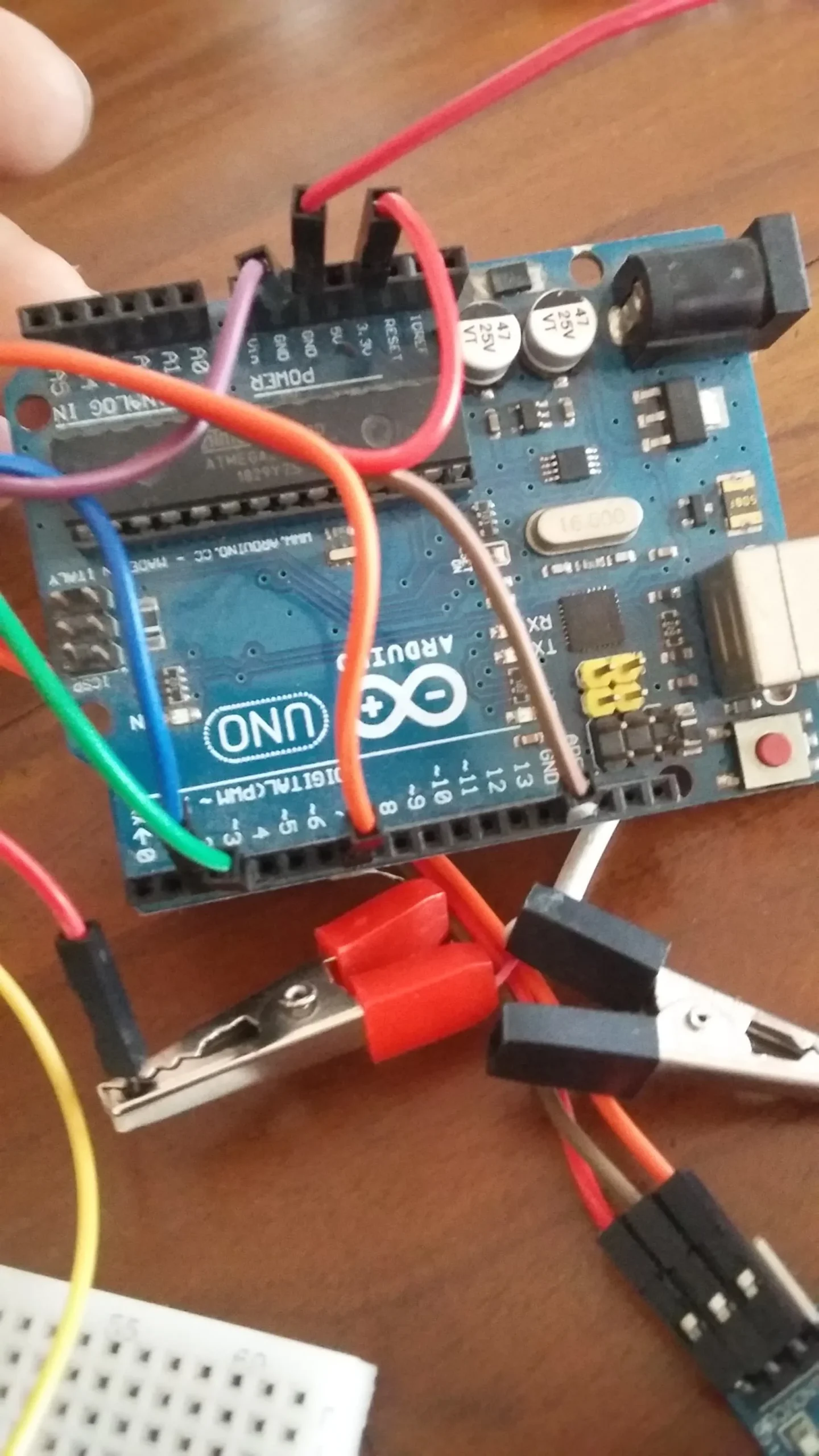
This image illustrates two of the most common real-world applications for RG316 cable. On one side, it shows its use as a short antenna pigtail or extension inside an IoT device or wireless router, connecting a mainboard's connector (e.g., U.FL/IPEX) to a chassis-mounted antenna. On the other side, it demonstrates its role in the lab as a flexible test jumper connecting instruments like a signal generator to a spectrum analyzer, highlighting its flexibility and durability on a crowded bench. The thin diameter and high-temperature rating make it perfect for both scenarios.
- RF test leads – Flexible jumpers that connect instruments on crowded lab benches.
- GPS and navigation devices – Compact feeds for modules where space is at a premium.
- Aerospace and defense systems – High-temperature harnesses in aircraft or satellites.
- Outdoor short-run connections – Rugged enough to survive sun, dust, and freezing weather.
For example, a common use case is connecting a Wi-Fi module with an SMA connector to a chassis-mounted antenna. The run may only be 20 cm long, but that’s enough for RG316: flexible, heat resistant, and reliable.
Another scenario is inside avionics. Many aerospace harnesses include RG316 because its FEP jacket won’t break down under extreme heat or chemical exposure. That kind of resilience makes it indispensable where ordinary PVC-jacketed cables would fail.
The takeaway? Use RG316 for short, tough jobs. If your design needs long cable runs, move up to RG58, RG223, or LMR-type cables to keep losses under control.
How to Use RG316 Cable with Connectors
Termination methods:
- Crimping: The most common method. It’s quick, consistent, and provides solid electrical contact when done with the right tool.
- Soldering: Often used for prototypes or repairs. It allows fine control but takes longer and requires more skill.
When preparing RG316, the small diameter means you need precise stripping. Too much force and the inner conductor bends; too little and the shield won’t seat correctly. Always use the proper gauge dies for your crimping tool.
Practical tip: For SMA connectors on RG316, crimp-style plugs are the easiest option. Cut the jacket clean, flare the braid evenly, and double-check that the dielectric isn’t nicked. A bad crimp introduces loss and, worse, intermittent performance.
In field work, many technicians carry pre-assembled RG316 jumpers with SMA connectors. It saves time and avoids the risk of poor assembly in less-than-ideal conditions. For production, though, precise crimping under controlled conditions is the best way to ensure repeatable results.
FAQs About RG316 Cable
Q: How much power rating RG58 and RG316 cable?
A: At 1 GHz, RG316 ≈ 85 W for a common double-shield build (RG316-DS). Some RG316/U variants are rated ≈135 W under 25 °C, sea-level CW conditions. A typical RG58C/U is ≈44 W at 1 GHz.
Q: What is the difference between RG174 and RG316?
A: Both are thin 50-ohm coaxial cables, but RG316 uses a high-temperature FEP jacket (rated up to 200°C) while RG174 usually has PVC insulation with a much lower rating (~80°C). Loss performance is similar, but RG316 is more reliable in aerospace, defense, or outdoor environments.
Q: Which cable is high power rating between RG58 and RG316 cable?
A: For typical catalog parts at 1 GHz, RG316-DS (~85 W) is rated higher than RG58C/U (~44 W). Certain RG316/U datasheets list ~135 W at 1 GHz; actual limits depend on construction, ambient temperature, and VSWR.
Q: What do the numbers stand for in RG316?
A: “RG” stands for Radio Guide, a military designation dating back to WWII. The numbers (174, 316, 58, etc.) come from the MIL-C-17 standard and serve as identifiers. They don’t follow a strict numeric logic, but remain industry shorthand today.
Q: How to connect RG316 cable to FrSky RX?
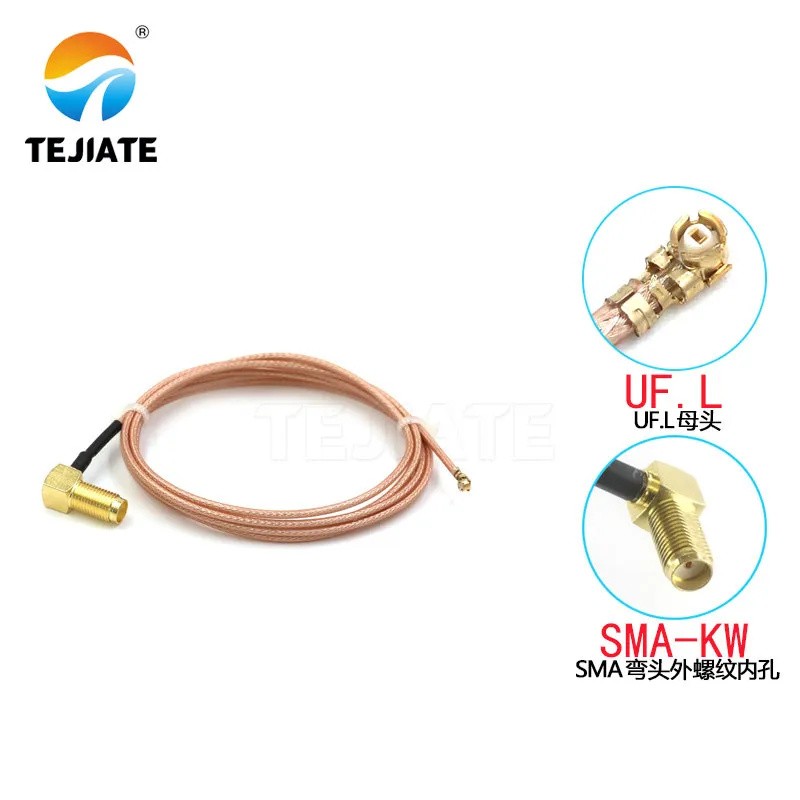
This is a macro-style photograph of a specific adapter cable used to solve the connection problem mentioned in the FAQ. It features a short length of thin, brown RG316 coaxial cable. One end is terminated with a tiny, delicate U.FL (or IPEX) connector, which is designed to plug directly into the miniature RF port found on FrSky and many other wireless receivers. The other end is terminated with a robust, threaded SMA male connector, allowing the user to connect a standard external antenna. The image emphasizes the physical interface solution and the cable type used.
A: Carefully strip the jacket and dielectric, slide the ferrule into place, flare the braid, and use the correct crimp die size. SMA crimp plugs are the most common. Precision is critical—poor crimps increase return loss and cause instability.
Q: Is RG316 ok for VLF?
A: Yes, but it’s unnecessary. At very low frequencies (kHz range), attenuation is negligible on any coax, so RG316 offers no special advantage. It’s mainly intended for GHz-band use.
Q: Where can I buy RG316 coax local?
A: Most electronics distributors, RF suppliers, or online marketplaces carry RG316 coaxial cables. For assemblies with SMA, MCX, or BNC connectors, specialized RF suppliers like TEJTE offer ready-to-use jumpers.
Q: RG316 jumpers for bench?
A: Yes. Many engineers keep RG316 SMA jumpers on hand for lab test setups. They’re flexible enough to route around crowded benches, but keep them short (<1 m) to limit loss.
Q: Is RG316 compatible with RG173?
A: Not mechanically. RG316 has an outer diameter of ~2.5 mm, while RG173 is different. Connectors sized for one won’t fit the other, even though both are 50 Ω cables.
Q: What gauge is RG316?
A: The inner conductor of RG316 is roughly equivalent to 26 AWG, usually formed from seven silver-plated copper strands.
Q: What is RG316 cable used for?
A: Common uses include antenna pigtails, GPS feeds, IoT modules, aerospace harnesses, and RF test jumpers. It’s chosen when flexibility and heat resistance are more important than low loss.
Q: Can a RG316 be used with a RG173?
A: Electrically both are 50 Ω, but physically they differ in size. Unless you use an adapter or connector designed for each cable, they won’t mate correctly.
Q: Using RG316 jumpers ok for bench?
A: Yes. Short RG316 jumpers are standard in RF labs. Just remember the loss adds up quickly at higher frequencies.
Q: How to solder SMA connector RG316?
A: Tin the center conductor, insert it into the SMA pin, solder carefully without overheating the dielectric, then secure the braid with the connector body. Soldering is best for small batches or repair; for production, crimping is faster.
Q: How to use RG316 cable for RX antennae?
A: For receiver antennas, RG316 is often used as a short extension or jumper. Keep the length minimal (usually under 30 cm) to reduce signal loss, especially at 2.4 GHz and above.
Conclusion
When it comes to RF cabling, there’s no such thing as a “one-size-fits-all” solution. RG316 coaxial cable earns its place not because it’s the lowest loss or highest power option, but because it balances size, flexibility, and temperature resilience in a way few others do.
Here’s the big picture:
- At just 2.5 mm in diameter, RG316 slips into places where RG58 or RG400 would never fit.
- Its FEP jacket and PTFE dielectric make it reliable from -55°C up to +200°C, ideal for aerospace, defense, and outdoor use.
- Loss is substantial—expect nearly 40 dB per 100 ft at 6 GHz—so keep runs short.
- Power handling is modest at ~35 W @1 GHz, fine for lab work and pigtails but unsuitable for base station feeders.
If you’re wiring up a Wi-Fi module inside an IoT device, or running a GPS antenna feed in an aircraft, RG316 is the right call. If you need to pump 100 watts into a rooftop antenna, you’ll be far better served by RG58, LMR200, or a heavier cable.
At the end of the day, the trick is knowing the strengths and limits of each cable type. RG316 isn’t built to do everything, but in its niche—short, rugged, high-temp links—it’s one of the most dependable tools in an RF engineer’s kit.
Explore More RF Guides
Want to dive deeper into related topics? Check out these resources:
- RF Connector Guide – side-by-side look at connector families.
- RF Cable Assemblies – pre-terminated options for lab and field.
- WiFi Antenna Types – from SMA whip to 5G panels.
Bonfon Office Building, Longgang District, Shenzhen City, Guangdong Province, China

A China-based OEM/ODM RF communications supplier
Table of Contents
Owning your OEM/ODM/Private Label for Electronic Devices andComponents is now easier than ever.
